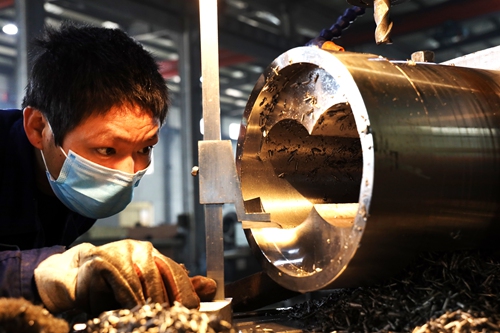HOME >> SOURCE
Vietnam’s GDP growth to suffer a blow from coronavirus: economist
Source:Global Times Published: 2020/2/18 17:52:37

A worker at a factory in Zhoushan, East China's Zhejiang Province, produces a molding machine screw on Thursday. Currently, many enterprises and factories nationwide have resumed production, while carefully ensuring containment of the CODIV-19 spreading. Photo: cnsphoto
The coronavirus epidemic in China has brought severe disruptions to the country's domestic production capacity and the global industrial chain. Of China's neighbors, an economist says Vietnam's GDP growth may suffer a heavy blow while Japan's economy could be hurt.Electronics, automobile, machinery and textile sectors have taken the greatest hit due to their scale and a high level of dependence on Chinese inputs, according to Alicia Garcia Herrero, a fellow at Asian Financial Think Tank and chief economist for Asia Pacific at NATIXIS Bank.
However, the actual economic value of the supply chain disruption is most profound for Japan, South Korea and the island of Taiwan considering their more integrated supply chains with China's mainland and Southeast Asia, Garcia Herrero wrote in an article published by the think tank.
While Vietnam's GDP decline is the greatest through its value chain, it is notable that the country's GDP surpassed 7 percent in 2019 and may continue to top growth in Asia even with the supply chain drag.
Though the impact on Japan's GDP growth might prove to be mild, it is the largest Asian economy outside of China, so "the nominal value of that is the second highest, only behind South Korea." From a global value chain disruption and nominal value perspective, it means the impact will be mostly felt by South Korean and Japanese firms, according to Garcia Herrero.
She noted that the shutdown of epidemic epicenter Hubei Province and restrained reduction of activities in areas such as South China's Guangdong have directly hit the regions' production lines. A sizeable investment in Southeast Asia depends on Chinese inputs for production.
On Monday, major labor-intensive provinces in China resumed production, highlighted by high population flows in the Pearl River Delta and Yangtze River Delta regions.
In Chinese manufacturing hub Foshan, Guangdong Province, at least 600,000 workers returned to work and the local resumption ratio among large-scale enterprises surpassed 50 percent on Saturday.
The economist underscored that the world is now more exposed to China than it was in 2003, when the country was hit by the SARS epidemic and its manufacturing export share remained at only 8 percent then; by 2018, it had soared to 19 percent. That means a supply chain disruption will have a greater impact than before not just in Asia, but also in the US and Europe, Garcia Herrero said.
Global Times
Posted in: INDUSTRIES,ECONOMY